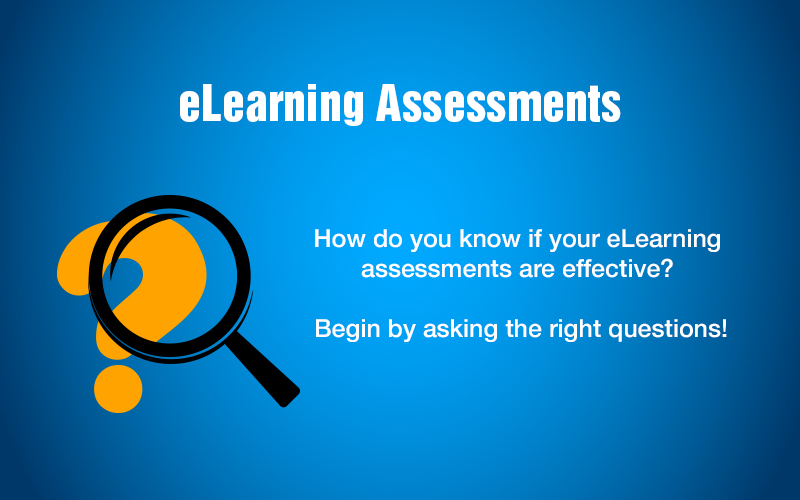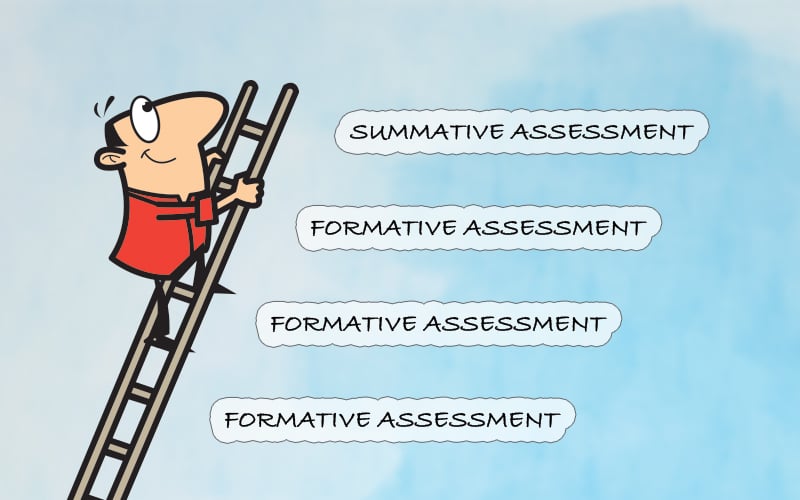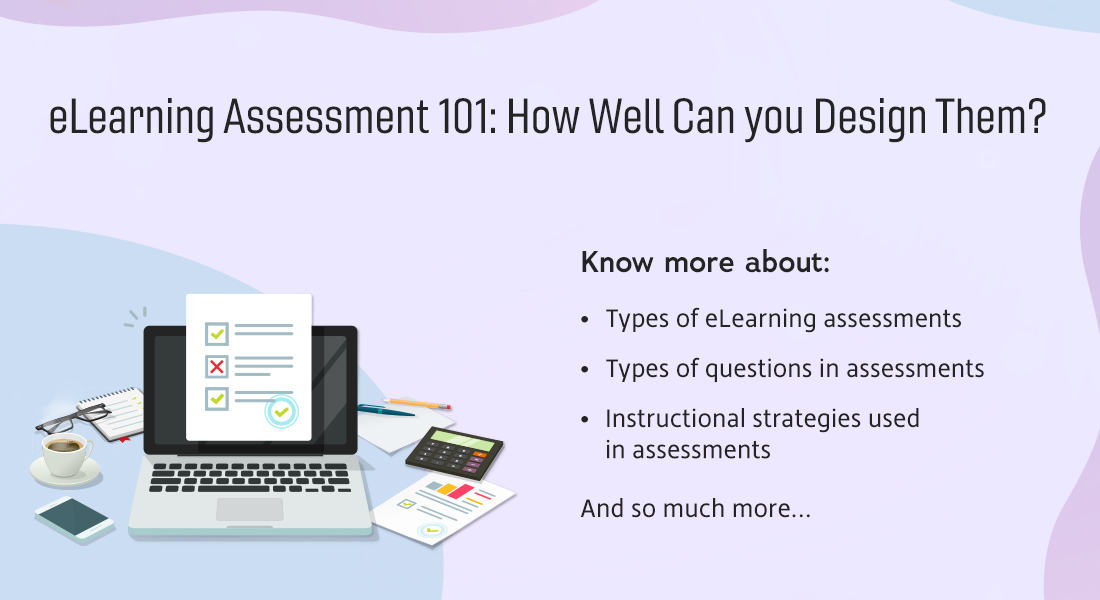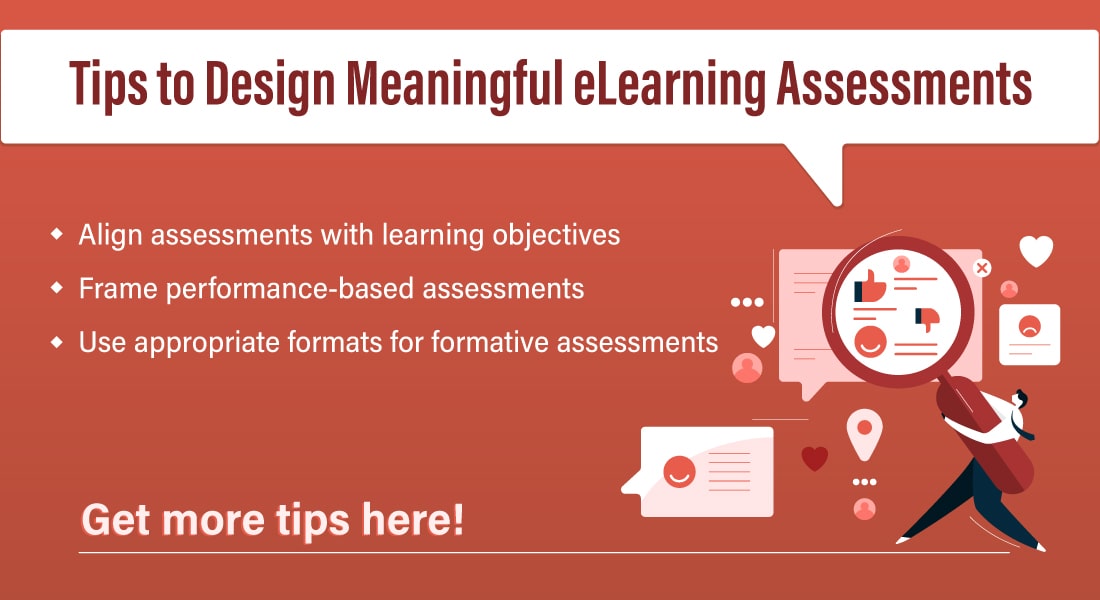Assessing Your E-learning Assessments: Do They Hit the Mark?

ELearning Assessments! With modern learning management systems, tracking assessments and scores has become much easier. But how do you gauge if the assessments in your eLearning course are doing what they are supposed to do? Here are 5 questions to ask when assessing the effectiveness of eLearning assessments for your corporate learners.
Assessing eLearning Assessments
What are the 5 questions to assess eLearning assessments?
- Are the assessments performance-based?
- Are both formative and summative assessments included?
- Which question types were used where?
- Are other types of questions used during the course?
- How frequently do formative assessments appear in the course?
5 Questions to Assess eLearning Assessments
1. Are the Assessments Performance-based?
The goal of an assessment is to measure if the learning objectives (LOs) are met. eLearning assessments should map to the LOs and need to be framed right after the learning objectives are set. For this process to work effectively, the learning objectives should be performance-based and framed with appropriate action verbs.
Why performance-based assessments (PBAs) instead of knowledge-based assessments? Because as Patti Shank, Ph.D., CPT says, “How can you assess if learners can develop an appropriate diet and fitness plan without having them develop the plan to see how well it was done? You can’t. A test isn’t adequate”.
PBAs assess actual or simulated performance, and they are time-bound and product/process-oriented. Each performance-based objective has three components:
Performance: Description of the action of skill
Condition: Description of the tools/resources available for the learner to perform the skill
Criteria: Description of the acceptable performance of the skill
You need to check if your assessments are aligned with the learning objectives, and that they are performance-based! If the learning objective of a software training module says, “Learners will be able to identify the different parts of a machine”, the assessment should be – “Label the parts of the machine, by dragging and dropping the labels in the appropriate boxes”.
Download this mini guide on the basics of instructional design.
2. Are both Formative and Summative Assessments Included?

Formative Assessments
Formative assessments are used to reinforce learning during the training. Unlike summative assessments, they are diagnostic in nature and used to aid learning. They come after every enabling objective and should always be provided with feedback – for both right and wrong answers. Formative assessments can be given in any format, and are not restricted to single select multiple-choice questions (MCQs). What you have to check is whether they are provided after every topic and if the feedback provided is appropriate.
Summative Assessments
Summative assessments indicate the learner’s final achievement in the course, and they are used to measure learning at the end of the course. They should be aligned with the objectives of the course, and they are graded to check if learners ‘pass’ or ‘fail’.
Another point to note – if you do not want to repeat the same questions to all your learners or want to offer different questions at different attempts, you can use a question bank that enables random picking of questions.
3. Which Question Types were Used Where?
There are many question types you can use in formative assessments. Five of them are given here:
- Fill in the blanks
- True/False
- Multiple-choice questions (MCQs): Single or multiple select
- Match the following (drag and drop, drag and match, drop down)
- Others (branching-scenarios, simulations, gamification)
Branching-scenarios, simulations, and gamification are used to check how the learner makes decisions based on the actions they take. They offer a fun learning environment that motivates and engages learners.
Remember that for summative assessments, you should go for MCQs, preferably single select. This makes evaluation simpler. Also, keep in mind that it is not necessary to provide feedback for summative assessments.
4. Are Other Types of Questions used During the Course?
Questions can be used to provide a transition between major sections and reinforce learning. Apart from formative and summative assessments, various other types of questions can be included in your courses:
- Do you know questions – stimulate the learner to think about a topic
- Can you recall questions – give the learner an opportunity to retrieve information
- Pre-test questions – used to manage navigation where the learner’s response takes them to the relevant part of the training
5. How Frequently do Formative Assessments Appear in the Course?
The more the frequency, the more the reinforcement and retention of learning! Formative assessments are usually provided after every learning unit, but with important topics. For example, in safety training, they may be used more frequently as there is a greater risk if the task isn’t performed well.
Now that you have the 5 questions to assess the assessments, let’s look at some best practices for e-learning assessments.
For Multiple-Choice Questions
- Options: There should be no clues that would reveal an option as the correct answer.
- Distractors: They should be consistent and belong to the same family.
For Summative Assessments
- Passing score for important topics: Instead of setting the same passing score for (60 or 80%) every topic, different pass criteria may be assigned for different topics, depending on their importance and criticality. For example, a pass criterion of 100% may be assigned for more important topics such as compliance training and safety training. For others, the passing score could be less.
- Higher marks for important questions: Instead of allotting the same score for every correct answer on the test, higher marks (2 or 3 marks) may be given for questions that are more complex or more important than the rest (1 mark).
- Result page: Learners need to be informed when the test has ended, and the page should be designed according to their scores. If the learner achieves the passing score or higher, they can be directed to a printable certificate page. Those who did not should be directed to a page that offers them a chance to retry the quiz.
Final Thoughts!
A course completion certificate is an important part of eLearning assessments. It will act as an extrinsic motivator for your learners to take the course. On completion of the course, your employees can also share their certificates on social media, inspiring their peers to take up the course. So consider these points the next time you are assessing eLearning assessments. With these 5 questions and answers to guide you, you can’t go wrong!
That was a checklist for effective assessments, but if you want to know about providing effective eLearning for corporate training, click the link below. It’ll take you to a free eBook that talks about making your training learner-oriented by focusing on six right brain aptitudes.





![4 Questions on Performance-based eLearning Assessments Answered! [Infographic]](https://blog.commlabindia.com/hubfs/Imported_Blog_Media/elearning-assessment-design-considerations-1.jpg)